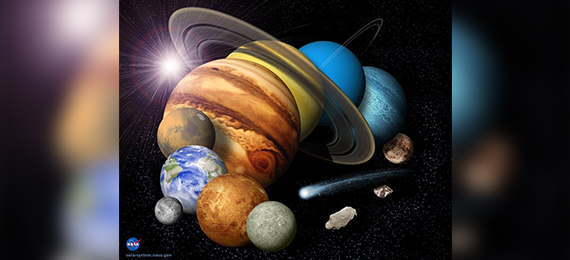
There are numerous planetary systems in the cosmos that are similar to ours, with planets orbiting a host star. Our solar system is called after our Sun, Sol, which is derived from the Latin word “solis,” which means “sun,” and anything associated with the Sun is referred to as “solar.” Here we covered some of the interesting facts about the planets.
Fun Facts About the Planets and Solar System.
- No matter how we look at the sun, there is always something interesting about the Sun. Scientists observe these changes by watching the sunspots, which increase and decrease about every 10 years.
- When compared to Earth, the sun is bigger. The radius of the sun is more than 432,000 miles and the Earth’s radius is just under 4,000 miles.
- Mercury is not the hottest planet in the solar system. As it stays closest to the sun, Mercury is both extremely hot and extremely cold.’
- There are dozens of moons in the solar system but both Mercury and Venus have no Moons.
- Venus is known as a fiery planet because of its high temperature and high pressure on its surface. When the Soviet Union’s heavily shielded Venera spacecraft landed on this surface in 1970, it lasted only a few minutes
- Despite being away from the Sun, Venus is the hottest planet compared to mercury. Its mean temperature is about 462°C.
- A day in Venus is longer than a year. That is 243 days on the earth is equal to one rotation in Venus.
- Earth is not flat and it is not perfectly round either. The variation between north to south, east to west and the equator may seem to differ in tiny quantities, but it is not perfectly round either.
- The days on earth gradually increase. When the earth was formed 4.6 billion years ago, it was just 6 hours long. After 620 million years ago it was 21.9 hours long and now it is 24 hours long on average.
- Earth is the fifth-largest planet in our solar system and it also has one large natural satellite called the Moon.
- The surface of Mars has the biggest volcano, craters, and deep valleys. The largest peak on this planet is called Olympus Mons which is three times higher than Mount Everest.
- When compared to other planets Mars has more missions. Because Mars is considered as the future human habitat. But this planet has huge dust storms every now and then that cover the entire planet.
- On Earth you have noticed hurricanes, the strength of these storms is much lesser when compared to the ones near Neptune. According to NASA, winds blow at more than 1,100 miles per hour (1,770 kilometers per hour).
- Uranus is the seventh planet from the Sun, at a distance of 2.88 billion km. This planet is much colder than Neptune. The average temperature of this planet is 72 K (-201 °C/-330 °F), which now reaches 55 K (-218 °C/-360 °F).
- When compared to Earth’s moon Pluto is the smallest planet. The planet Pluto was discovered by a young research assistant in the year 1930.
- Pluto is the furthest planet from the Sun, but in reality, its orbit is so eccentric, that it comes closer to the Sun than Neptune.